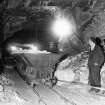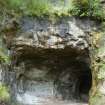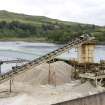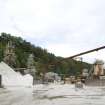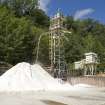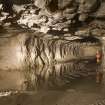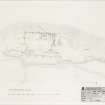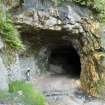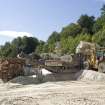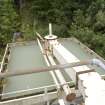Following the launch of trove.scot in February 2025 we are now planning the retiral of some of our webservices. Canmore will be switched off on 24th June 2025. Information about the closure can be found on the HES website: Retiral of HES web services | Historic Environment Scotland
Lochaline, Silica Sand Mine
Mine (Period Unassigned)
Site Name Lochaline, Silica Sand Mine
Classification Mine (Period Unassigned)
Alternative Name(s) Loch Aline; Tarmac; Charles Tennant And Co; Tilcon
Canmore ID 289085
Site Number NM64SE 38
NGR NM 680 450
Datum OSGB36 - NGR
Permalink http://canmore.org.uk/site/289085
First 100 images shown. See the Collections panel (below) for a link to all digital images.
- Council Highland
- Parish Morvern
- Former Region Highland
- Former District Lochaber
- Former County Argyll
Field Visit (August 2008)
NM64SE 38.00 680 450
NM64SE 38.01 NM c. 6807 4515 Pier
Location
The village of Lochaline and the Loch from which it takes its name are situated 40 miles from Fort William, 18 miles from Oban and a short ferry ride from the Island of Mull. The silica sand mine sat by the banks of Loch Aline directly below the village and was naturally camouflaged by trees and cliffs. The site was restricted to a long, narrow strip of land some 790m in length by 95m in width, bounded by the loch on the E side and rock outcrop on the W. The mine began operations in 1940, expanded throughout the 1940s - 1960s and finally closed in 2008.
Silica sand
Silica sand is a loosely cemented or unconsolidated form of silicon dioxide (SiO2). The term ‘Silica Sand’ is an industry term used to describe Silica or industrial sands containing a high proportion of silica (up to 99%) in the form of quartz and little in the way of impurities such as clay, iron and chromite. Silica sand is therefore derived from naturally occurring sands and by crushing sandstone.
Sand is usually quarried where the overburden is removed. The sand is scraped, processed and shipped by road or by boat. It can also be mined where the overburden is great and where the geology allows for a stable working area roof structure, such as at Lochaline.
When processed, glass sand has the appearance and texture of castor sugar and has a narrow grain size (0.5mm to 0.1mm). Silica sand is a major raw ingredient of glassmaking and a wide range of other industrial and horticultural applications. In the past, foundry casting was a major source of orders from silica sand producers. There has been a significant fall in the demand for foundry sand due to the decline in UK heavy manufacturing.
The use to which the sand is put defines its processing. Its geological or mineralogical makeup also determines its use: for example, the chemical composition for glass sands is far more important than in foundry sand where the physical properties are paramount.
Lochaline mine always concentrated on providing silica msand for the glassmaking industry and thus reflected the relatively recent growth of this demand for glass sand. In 2004, 53% of silica sand supplied by the UK was for the glass industry. (1) The balance made up of foundry sand (11%), other uses (19%), horticultural and leisure (17%).
There are many uses for silica sand such as a foundry Sand, fracturing and cementing in oil wells (‘Fracsand’), as an additive in construction chemicals and sealants, as a filter media for water filtration and purification, as a filler in paints and powder coats, for sand blasting and as a raw material for glass manufacturing. Lochaline silica was of a grade specifically for the latter use, including high definition TV screens (for Pilkington), abrasives such as Silicon Carbide (silica sand and coke heated to 2000 degrees celcius) for the Norwegian market and for building construction. Lochaline mine produced around 100 000 tonnes of silica sand per year by 2008, approximately one fifth of all Scottish production.
Geology
The geology of the Lochaline area has one of the few Cretaceous chalk deposits in the British Isles. This takes the form of white silica sand that was laid down 135 million years ago, protected from weathering by an overburden of younger (Tertiary) more weather-resistant basalt lavas. The sandstone seam, which is 3-12m in thickness, is grey in colour and rich in alumina and iron oxide for the first 1-2m. Below this, for 5-8m in depth, the sand is pure white in appearance and virtually free of impurities. The base is a greensand. Above this pure band of sand the ‘ribs’ of re-crystallized silica range in thickness from a few centimetres to 0.5m and this gave Lochaline mine its stable roof. There are only occasional bedding planes visible in the sandstone. There was faulting and igneous dykes, up to 40m across in places, which determined the extent of underground workings as well as the extent of the sand deposit.
Brief history of Site
Lochaline was the only silica sand mine (as opposed to an open quarry) in Britain and the most northerly extraction site. (2) It was the only source in Britain suitable for high grade domestic and decorative glassware including table glass and borosilicate glass for laboratory and scientific use. (3) The sand is 98.8% quartz with a grain size ranging from 100-500 microns with impurities existing in almost negligible amounts. Silica sand extraction in Britain is generally by quarrying where the overburden is removed. Such areas producing sand are the Scottish Central Belt (and Fife), the English Midlands and the SE of England.
Deposits of sand were known of in the late 19th century but it was only in 1923 that the Edinburgh Geological Survey carried out an analysis of sand sample which was found to be 99.69% silica. At that time there was a low price on imported glass sand, and together with the remoteness of the site, it was considered uneconomical for silica extraction. In 1934 cores were sent to the United Glass Bottle manufacturers (UGB) resulting in a small adit being driven below High Street, Lochaline (unlocated). Twenty tons of sand were bagged up for UGB as a result of the analysis of these cores, but this was found to contain iron oxide impurities and abandoned.
In 1939 UGB took more interest in the site as a source for clear glass when the outbreak of World War II was imminent. The invasions of Belgium and France disrupted the supply of high quality optical glass sand to the Allies during WWII. As a result, the supply at Lochaline was considered and Charles Tennant and Co., Glasgow took over the operation. By July 1940 a manager and 12 men had moved to Lochaline to set up the mine. Tools and equipment for the new venture were commandeered from Ballachulish Slate Quarries, owned by Charles Tennant & Co., where production had been curbed due to hostilities. (4) By 1945, 35,000 tons of sand had been produced with customers including Pilkington, Chance Brothers and Edinburgh Crystal. By 1948 this yearly production had increased to 52,000 tons, and by 1962 it had reached 61,000 tons.(5) In 1940, 35 men were employed on site, and by 1950s up to 65 men worked on site both above and below ground.
Broadly, the S and NE of the site were worked in the 1940s and 1950s and the NW in the 1960s and up to the present day. By the 1980s, the underground working at Lochaline had been expanded to the North and West, undermining the N end of the village. The adits were sunk over time as the underground working moved N. No. 5 adit was visible adjacent to the flotation tanks at (DC 48438, N). There were 9 adits by the 1980s (6) and 12 by 2008 being as mix of adits for removing the silica and for ventilation. (7) There was water in the mine, mostly re-circulated waste water from the washing process. The older workings were not accessible on the date of visit (May 2007).
Extraction
The pillar and stall technique of mining was employed in the mine. The main heading was driven 1000 feet due N from the mine entrance and between 25 and 50 feet above Ordnance Datum by 1943 (Adit 1: NM 67948 44839; Adit 2: NM 67957 44842; Adit 3: NM 67962 44869). Generally, the 1940s and 1950s saw increased production although flooding, ventilation and geological problems were encountered in the area N of the current mine managers office (NM 68005 44964).
In the 1940s, the sand was extracted underground by ‘gelitol’ explosives (SC1072294). Drilling for placing the explosives was carried out using column mounted ‘drifters’ with drill ‘steels’ made in the Smithy (c. NM67944482, now gone) (8) and were run on compressed air (SC1072278). The benches were drilled using ordinary drills. The loosened sand was scraped and loaded into wagons (see SC1072280). The Holman scraper loader, working by compressed air, allowed better underground layout with ‘rooms’ up to 100 imperial feet in length (SC1072279) that opened at right angles to haulage roads. Turntables were also installed to allow for easily manoeuvre in cramped spaces (9).
The ventilation fans and the need to power the scrapers underground resulted in the introduction of electricity in 1943. A powerhouse was built and fitted with a diesel driven electric alternator.(10) By the late 1950s Tennant were awarded a major contract by Colgate to provide the sand for Ajax Power, and this saw the introduction of roving drills mounted on drifters and tractors.
By 2008, the extraction area was entered from No.7 adit (NM 68089 45462; DP029386). Drilling for setting explosives was done by a Boart Longyear twin boom drilling rig mounted on a truck (DP029429). The drill holes were made in preparation for advancing the mine face (DP029421). The stable roof provided a natural percussive surface to direct the blast and the working floor was stable greensand. Once an explosion had taken place, the mine was not re-entered for 24 hours until the dust settled.
Transporting
In September 1940 three lorries were used to transport sand from a mine opened in the cliff face just N of the burn near NM 6792 4482. Initially horses were tried out to haul the sand underground but this proved unsuccessful and a special arrangement was reached to operate a diesel locomotive below ground. Locomotives from the mine mouth to the processing site were operated from 1943 until 1963 (SC1072290; SC1072277). The rails were made by Krupp and had been commandeered from a captured German cargo ship. By the late 1950s, the major Ajax powder contract saw the replacement of the one yard wagon (DP029376) with a larger wagon (SC1072293), plus a tippler at the processing site. This reduced the number of wagons to trains of four underground and eight aboveground. (11)
Diesel trucks with front-ended loader (underground), tractors and trailers were used from the 1960s. By 2008, 30 tonne trucks were used to move the raw material from the mine face to the processing area (DP029346).
Processing
Processing at Lochaline took place at three sites in the 68 years it was in production. When the site was originally opened in 1940 sand was not processed and sand was shipped out by ‘puffer’ from the Old Pier (NM 6796 4462). There were various problems with this site and so the West Pier loading and processing facilities were built (NM 64SE 38.01; SC1072293), along with a railway line (SC1072277). The first shipment of sand from the new facility took place in July 1941.
The original plant at the West Pier was in operation until the 1960s and consisted of conveyors (SC1072291) and bunkers (SC1072293). The bunkers were slightly remodelled at various times, for example, by heightening the sides to increase capacity). The original plant consisted of a steel and wooden gantry (SC1072316), a jaw crusher, a rotating dry screen (later replaced by a vibrating screen with sprays), crushing rolls, a washer (wooden trough, 6 feet in height with a perforated bucket which lifted the slurry of sand and water from the washer and deposited it onto conveyor belt), counter shafts with pulleys and flat belts from a single cylinder 65HP Ruston and Hornsby diesel engine. Today, there are substantial remains of the West Pier processing superstructure which carried the conveyor and emptied the processed sand into the awaiting ship (SC1072316). The poor quality of the concrete construction is evident from photography (DP029378; DP029379).
In 1947, it was suggested that Tennants should improve their sand washing technique and so they installed a floatex cone (density separator) along with a Crossley Diesel engine to drive the pumps was installed. However, this was removed as it did not make an appreciable difference to the sand quality and was too expensive to run. (12) It is unclear where this equipment was located.
The late 1950s saw improvements to the West Pier plant due to the ‘Ajax’ scouring powder contract . The processing plant was moved to NM 68018 45163 (possibly) in the 1970s. In 1972 the site was sold to Tilcon who in turn sold to Tarmac in 2000. In 2008 there were 11 people on site. This included 6 underground staff: driller, shot-firer, underground shovel driver, 2 dumper drivers, underground supervisor) and 5 surface staff: quality control, fitter, electrician, plant operator, shovel driver. The mine workings cover some 1,500,000 square metres or 370 acres. The mine was closed in 2008.
The Site in 2008
There were various elements to sand processing at Lochaline. There was the Raw Sand stockpile area, Primary and Secondary Crushing areas, Screening, Washing and Shipping areas.
Raw Sand Stockpile area
Sand was removed by lorry from the working face and dumped in a stock pile adjacent to the crushing area (DP029398 left of image, DC48438, A) at NM 68008 45198. The raw sand was then loaded by bulldozer into a mobile crusher that carried out the first breaking up of the material. This first pass crushed material was emptied into a hopper (DC48438, B; DP029390-DP029396).
Secondary Crushing
The primary crushed sand moved from the hopper to the drag feeder (see DP029395; DC48438, C). A conveyor moved this material (DP029397, DC48438, D) to the Morgensen Sizer (DP029364; DC48438, E). This further sorted grain size by passing the crushed sand through a mesh. Any sand that did not pass through the mesh was passed into the Hazemag crusher (below the Sizer) for secondary crushing and grain size sorting (DC48438, E).
Screening
The sand from the primary and/or secondary crushing process was then sent for screening via conveyor No.2 (DP029399; DC 48438, F) to the Surge Bin (DP029367; DC48438, G). When this bin was full (material batched into the system), it was shut off from the primary crusher material (which at this stage was still standard quarry item and water). The material was then ‘belted’ onto the Allis Chalmers screen (DC48438, H; DP029367) via Conveyor no. 3. This material was washed and the plant rejects - grains greater than 700 microns - were discharged and taken back to the mine by truck. The material which was left was in water suspension. This was then pumped from the Allis Chalmers screen to the Eagle Screw via a pipe (DP029354; DC48438, K).
Washing
Washing was a simple and low cost method of cleaning the silica sand by the removal of clay minerals. First, the water and silica suspension made its way to the attrition scrubber (DP029358; DC48438, L). The sand and water was then sent to the flotation tanks or ‘Floatex’ density separators (DP029366; DC48438, N) where the sand settled out from the clean water. There were two density separator flotation tanks at Lochaline with one for standard grains (greater than 250 microns) and one for ‘fines’ (less than 250 microns, more than 90 microns).
All of the sand was then passed into the Floatex tank 1 (DP029356). This then 'floated' off the smaller grain sizes (less than 250 microns) which were in a suspension into the second (fines) Floatex tank 2. The remaining sand (greater than 250 microns) was then pumped to either Tower no.1 (DC48438, O; Yard 1) or Tower no.3 (DC48438, Q; Yard 3) via a hopper at the base (DP029366). This was shipped to Tarmac at Runcorn, Cheshire for dispersal and further processing by customers.
The fines Floatex (no.2) floated off what were called 'superfines' less than 90 microns and these were pumped back underground. The remaining sand (fines) was pumped to Tower no.2 (Yard 2, less than 250, greater than 90 microns; DC48438, P; DP029402). These ‘fines’ made up 10% of the mine output.
Yard 3, No 3 tower (standard fines) was known as the Norway Yard (DC48438, Q) because this tower was added later and was used to stockpile better quality standard sand for Norwegian customers for carbide manufacture.
The spiral separator (DC48438) was a redundant piece of kit installed in the 1980s before the flotation system was adopted. This was adjacent to the Floatex Tank no.1.
Shipping
The sand was pumped from Towers 1 and 2 and collected in piles below the towers (DP029407). Processed sand was then put into the feeder hopper (by truck). The material was then fed onto Conveyor 4 (DC48438, S) which ultimately moved the material from the jetty (DC48438, T) onto a waiting boat.
Acknowledgements
I wish to thank Peter Davis (Lochaline Mine Manager, TARMAC) and Peter Lindsay (Lochaline Mine, Production Manager, Tarmac), for explaining the site and providing access to archive material. I also thank Alastair Scoular, Lochaline resident since the 1940s, ex-miner and local historian for his time. Also, I would like to extend my thanks to my colleague Angus Lamb, Ian Thornber for informing RCAHMS about the site and Lesley Smart (Lochaline Mine, Administrator).
Source : Oban Times, http://www.obantimes.co.uk
Glossary
ADIT: near horizontal access passage to a mine used for transport, ventilation or drainage (or all three)
ATTRITION SCRUBBER: ‘rubs’ or agitates the particles together to further remove sand grain adhering impurities
BENCHES: the elevations being worked in a mine within the ‘room’
CRUSHER: mechanical means of rendering down large lumps of mine or quarry material into smaller lumps prior to finer refining
DENSITY SEPARATOR: separation of components from a suspension using gravity
DRAG FEEDER: a short conveyor with ribs across the moving belt which literally drags the primary crushed material onto the conveyor after the primary crushing of the material
FINES: refined quarry material
HAULAGE ROADS: underground roadways along which sand was removed from the mine
HOPPER: receptacle for holding material to be fed onto another part of a process
MICRON: unit of length of one millionth of a metre
PILLAR AND STALL: also known as ‘stoop and room’, an early mining method where minerals are extracted leaving pillars to support the roof
ROTATING DRY SCREEN: mechanically driven arrangement of fixed or vibrating bars or perforated steel sheets for grading mine product to loosen waste and dirt from the quarry item
SCREEN: mechanically driven arrangement of fixed or vibrating bars or perforated steel sheets for grading quarry product
SIZER: mechanical equipment for grading particles by size
TIPPLER: mechanical equipment for enabling the tipping of contents from a wagon
WASHER: mechanical equipment for the wet cleaning of quarry item
WET SCREEN: mechanically driven arrangement of fixed or vibrating bars or perforated steel sheets for grading mine product utilising water to loosen waste and dirt from the quarry item
(1) BGS Planning Factsheet, Silica Sand, Crown Copyright, (2006), 1. http://www.bgs.ac.uk/mineralsuk/downloads/mpfsilicasand.pdf. Retrieved, 13/7/2009
(2) BGS Planning Factsheet, Silica Sand, Crown Copyright, (2006), 8. http://www.bgs.ac.uk/mineralsuk/downloads/mpfsilicasand.pdf. Retrieved, 13/7/2009
(3) BGS Planning Factsheet, Silica Sand, Crown Copyright, (2006), 7. ‘The highest purity silica in Britain occurs in the Cretaceous-age Lochaline White Sandstone Formation on the Morvern Peninsula and on the isle of Mull on the west coast of Scotland’. http://www.bgs.ac.uk/mineralsuk/downloads/mpfsilicasand.pdf. Retrieved, 13/7/2009
(4) Notes entitled ‘The Early Years of the Lochaline Silica Mine’, and unpublished memoire by Donald Noel Paton the first manager of the mine, and written about 1960, 3, 4, 7.
(5) Notes entitled ‘The Early Years of the Lochaline Silica Mine’, and unpublished memoire by Donald Noel Paton the first manager of the mine, and written about 1960, 23.
(6) Tilcon, Loch Aline Ltd, Plan of Silica Sandstone Workings 1:1250 (19[80s]), British Geological Survey, plan no. LSP15148.
(7) Pers.comm. Peter Davis, Mine Manager, Lochaline, May 2007.
(8) Pers.comm. Alastair Soutar, former underground and surface worker at Lochaline Mine in the late 1940s and 1950s, Lochaline, May 2007.
(9) Notes entitled ‘The Early Years of the Lochaline Silica Mine’, and unpublished memoire by Donald Noel Paton the first manager of the mine, and written about 1960, 16.
(10) Notes entitled ‘The Early Years of the Lochaline Silica Mine’, and unpublished memoire by Donald Noel Paton the first manager of the mine, and written about 1960, 16.
(11) Notes entitled ‘The Early Years of the Lochaline Silica Mine’, and unpublished memoire by Donald Noel Paton the first manager of the mine, and written about 1960, 28.
(12) Notes entitled ‘The Early Years of the Lochaline Silica Mine’, and unpublished memoire by Donald Noel Paton the first manager of the mine, and written about 1960, 23.
Visited by RCAHMS (Miriam McDonald), May and August 2008.












































































































